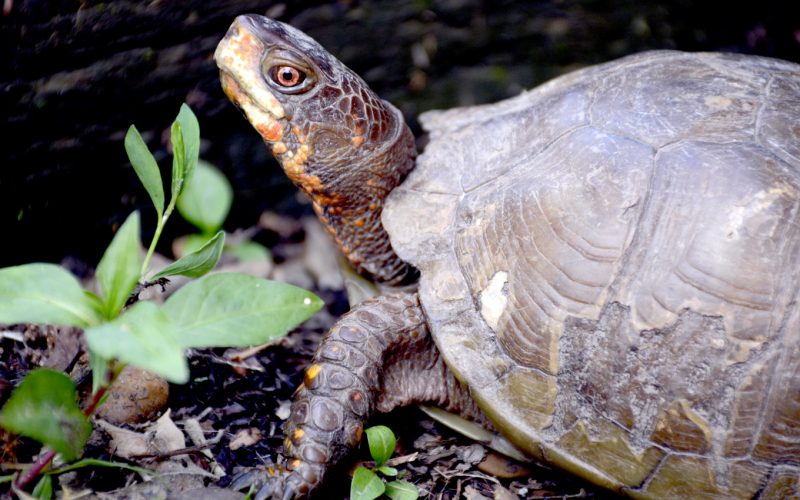
Staff Photo Amanda Bancroft
This Fayetteville three-toed box turtle is alert and watching for danger. It can completely close its body into its shell in self-defense.
A rustle in the grass outside the window points attention to a small pile of leaves moving in slow spurts across the ground. Suddenly, a bright red head with red eyes emerges, like Darth Maul from Star Wars. The force is certainly strong in this one, with the ability (rare in turtle world) to completely close its body into its tight shell when threatened – hence the name “box turtle” and the popular images of turtle shells speeding around Super Mario Brothers video games.
Unlike the game, turtles cannot remove their shell and throw it at you; they’re attached, and their shells grow with their bodies. The top of a turtle’s shell is called the carapace, the bottom is a plastron, and they are held together by the bridge, which allows spaces for the legs, tail and head to stick out. These reptiles have been around for a long time, even before the dinosaurs, and are sometimes called “living fossils.”
The three-toed box turtle (Terrapene carolina triunguis) is a common and brightly patterned local species. Their shell color is highly variable but not as painted as other species, and can be yellow, orange, olive or brown shades. Males may have an all-red head or just red blotches with other colors, and usually have a red iris in their eyes. They have hooked beaks and three (sometimes four) toes on each hind foot. Females are bigger than males, with both sexes becoming active from early April through late October in Northwest Arkansas.
Box turtles prefer grasslands in late spring and early fall when temperatures are moderate, but stay in forested areas during summer, early spring and late fall. They shelter under logs, in ponds, or in mammal burrows and shallow forms (burrowing sites in leaf litter).
They enjoy munching on a vast variety of foods, such as invertebrates, small vertebrates, eggs, roots, stems, fruit and even carrion. Even though they are omnivorous, they tend to eat mostly plant foods later in life.
Amazingly, females can lay eggs up to four years after mating! Kory Roberts, a biology teacher and herpetologist, explains some possible reasons for this behavior: “Turtles may encounter each other infrequently, so they mate while the getting is good. Females have slow reproductive cycling. They may not have developed eggs, even if they have mated. Females may need to reach a certain threshold of growth/size before they commit the energy needed to produce a clutch of eggs. Turtles aren’t in a terrible rush to do anything, even reproduce!”
Females lay one to six clutches of one to seven eggs each, spread about 19 days apart. Incubation takes anywhere from 80 – 102 days, depending on outdoor temperatures. Occasionally, twin turtles are produced from one egg!
You might see turtles crossing the road, especially after a rainfall. If you spot one, bring it across the road in the direction it was traveling – it will continue trying to cross the road in that direction if you don’t!
Amanda Bancroft is a Master Naturalist and volunteers with her husband Ryan for their solar-powered online educational center on how to make a difference with everyday choices at: www.RipplesBlog.org.










